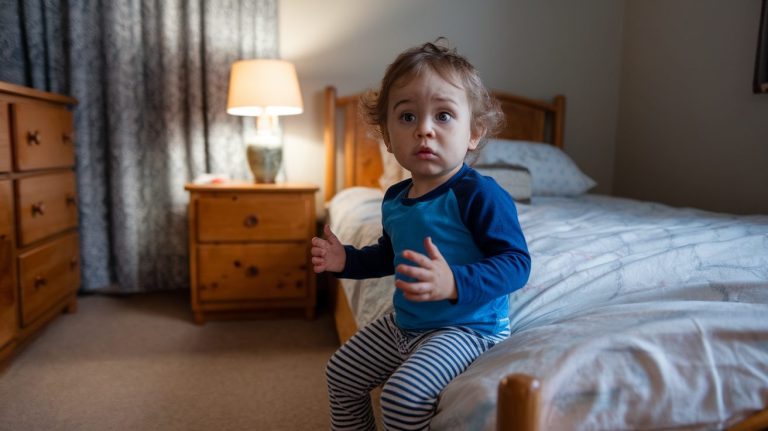Sleep troubles with toddlers can test any parent’s patience. If your 3-year-old keeps popping out of bed at 2 AM, you’re not alone. As a child sleep consultant, I’ve helped thousands of families get better rest.
Parents often tell me: “I’ve tried everything, but my toddler still won’t stay in bed!” I hear you. The constant wake-ups leave everyone tired and frustrated.
Here’s the good news: You can help your toddler sleep through the night with the right approach. In this guide, I’ll share proven methods that work based on sleep science and real results from families I’ve worked with.
You’ll learn:
- Why your 3-year-old wakes up
- Simple steps to keep them in bed
- How to handle middle-of-night visits calmly
Let’s help your family get the rest you need.
How to Transition From Crib To Bed?
The crib-to-bed switch is a huge milestone.
But here’s the thing: not every 3-year-old is actually ready for this change. Sometimes, our excitement about moving forward pushes us to transition too early.
Think about it: your crib is like a cozy nest with clear boundaries. A big bed? That’s like giving your toddler the keys to freedom.
Some key signs your child might not be ready:
- Frequent middle-of-night wandering
- Anxiety about the new sleeping space
- Difficulty staying in bed during initial tucking in
- Showing no interest in the new bed
There’s no shame in keeping your little one in their crib longer if that’s working.
Remember: every child moves at their own pace.
What’s Really Behind Those Bedtime Escapes?
Every parent knows that look – the one where your toddler has a million reasons not to sleep. But let’s dig deeper into what’s actually pushing them out of bed.
The Monster Under the Bed
- Your child’s imagination is blossoming at age 3
- Those shadows on the wall? They’re suddenly very real and scary
- That stuffed bear might look different in the dark
Growing Pains and Brain Changes
- Your 3-year-old’s body and mind are developing at warp speed
- Sleep patterns can get messy during growth spurts
- New skills and thoughts can keep their brain buzzing at bedtime
When They Don’t Feel Good
- Stuffy noses make lying down uncomfortable
- Teething can strike even at this age
- Sometimes, they just need extra cuddles when feeling under the weather
The key? Understanding their reasons isn’t making excuses – finding solutions that work.
How to Get Your Child to Stay in Bed?
Let’s talk about real strategies – no fancy tricks, just proven methods.
Create a Bedtime Ritual They Can Count On
- Keep the same steps every night: bath, books, cuddles, sleep
- Start winding down 30 minutes before bedtime
- No tablets or TV – they mess with sleep hormones
- Think calm activities like coloring or quiet play
The “Silent Return” Method
- When they get up, walk them back without talking
- Keep your face neutral – no angry looks or smiles
- Be boring – this isn’t playtime
- Repeat as many times as needed (yes, it might be 100 times the first night)
Gentle but Firm Boundaries
- Use a sticker chart for staying in bed
- Try a “bedtime pass” – one free pass to get up, then done
- Keep your cool – getting frustrated only makes it harder
This isn’t a sprint. You’re teaching a life skill that takes time to master.
Your Bedtime Victory Is Closer Than You Think
The bedtime battles with your 3-year-old won’t last forever, I promise.
It might feel like you’ll never have an evening to yourself again right now. But you’re one step closer to success every time you calmly walk them back to bed.
Remember:
- Your toddler isn’t trying to drive you crazy
- This is just a phase in their growing journey
- Small changes can lead to big improvements
Keep being that patient, loving parent – even when you’re tired. Before you know it, bedtime will become the peaceful transition it’s meant to be.
You’ve got this! One bedtime at a time.
Frequently Asked Questions
Why Does My 3-Year-Old Not Want to Sleep in His Bed?
It could be due to separation anxiety, fear, or changes in routine.
Is There a Growth Spurt at 3 Years?
Yes, many 3-year-olds experience physical and developmental growth spurts.
Is It Normal for A 3-Year-Old to Sleep with Parents?
Yes, co-sleeping is common, but transitioning to independent sleep is encouraged.
What Is the Cry It out Method?
It’s a sleep training method where parents let the child cry for set periods before comforting them.












